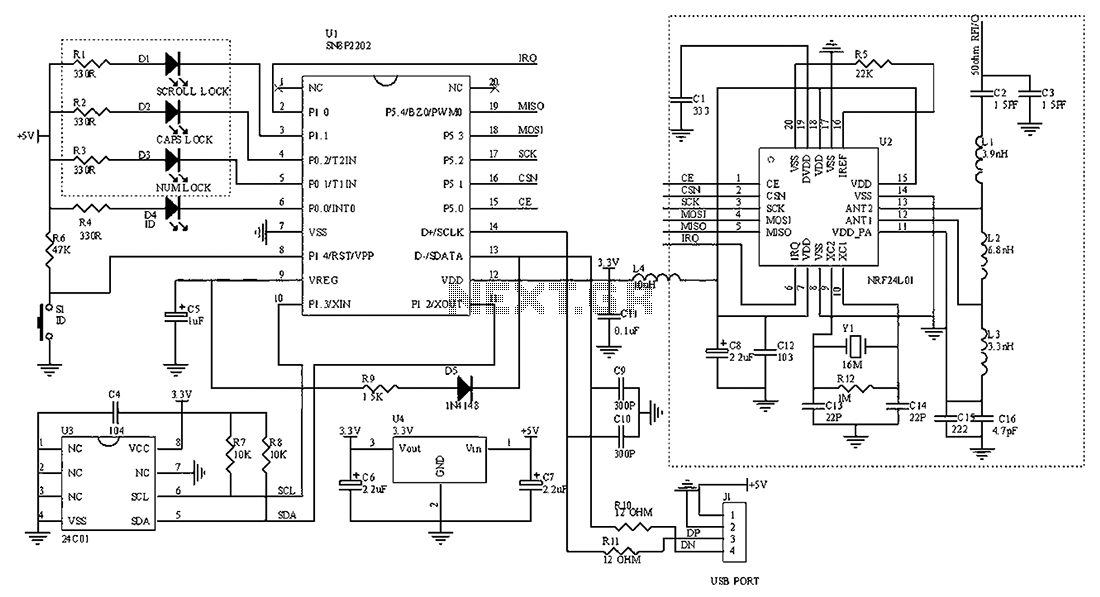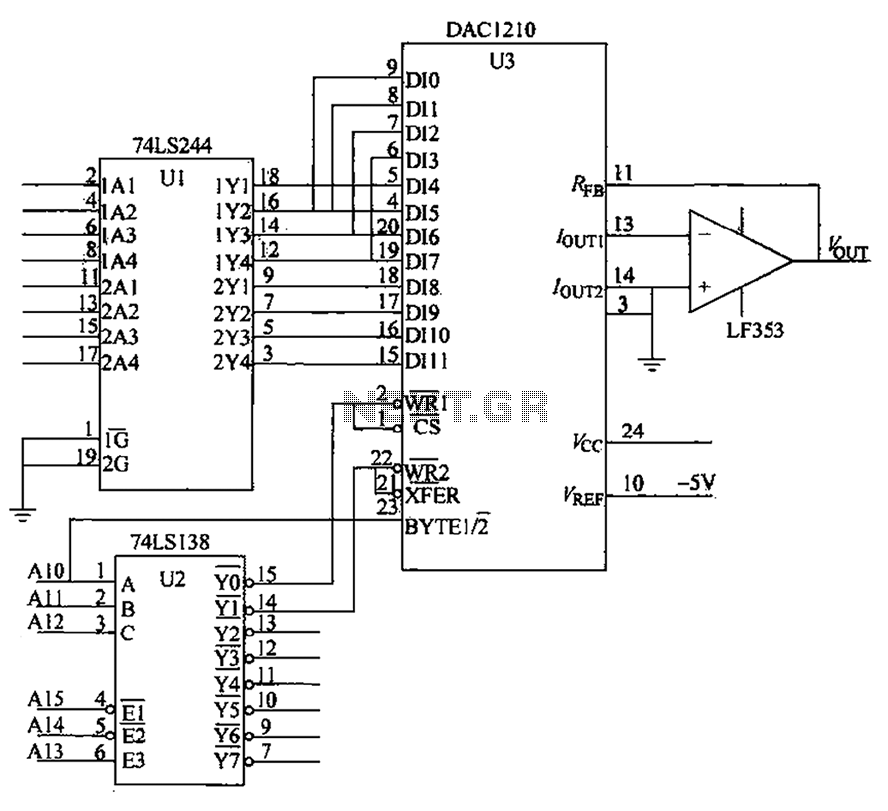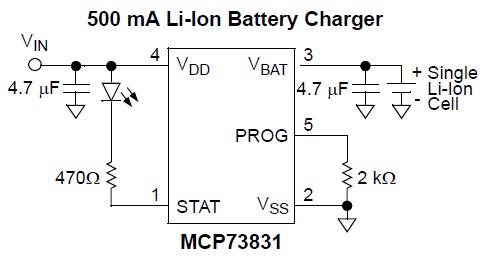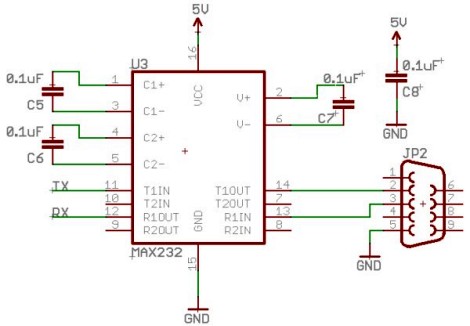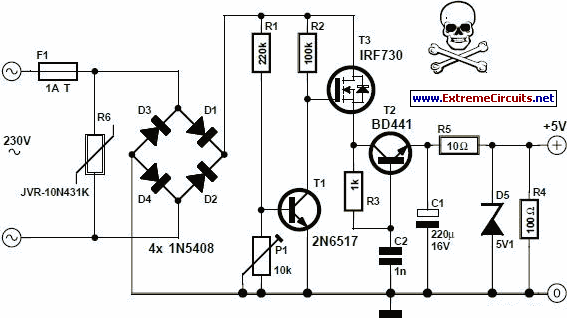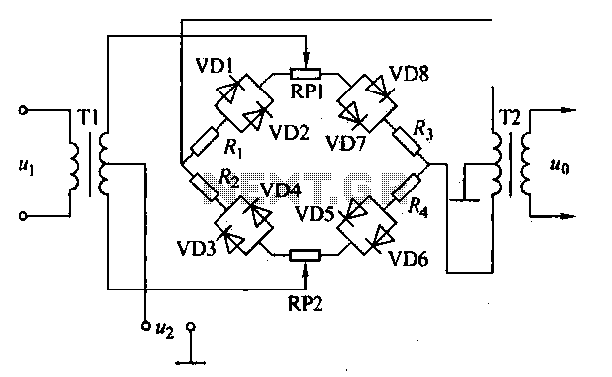
Simple Water Detector Circuit
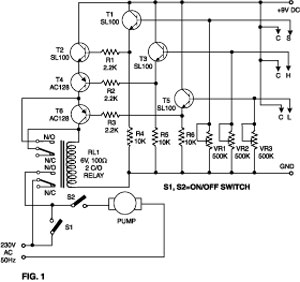
This simple water detector circuit utilizes alternating voltage to prevent the corrosion of the electrodes. It is straightforward to construct and employs N1 as a trigger Schmitt gate that generates the AC signal. When an electrical conductor, such as an aqueous solution, is present between the electrodes, the rectification action of diodes D1 and D2 causes capacitor C4 to charge. Once the voltage across the capacitor reaches the switching threshold of the N2 trigger Schmitt gate, the relay is activated, which can connect a drain pump. The pump will be deactivated as soon as the electrodes are no longer in contact with the liquid.
The water detector circuit is designed for reliable operation in various environments where moisture detection is necessary. The use of alternating voltage serves to minimize the risk of corrosion on the electrodes, extending the lifespan of the components. The circuit's core consists of two Schmitt triggers, N1 and N2, which are responsible for generating and processing the AC signal.
The first stage, featuring N1, produces an oscillating output that drives the diodes D1 and D2. These diodes are configured to rectify the AC signal, allowing only the positive half-cycles to charge the capacitor C4. The capacitor serves as a voltage storage element, and its charging behavior is critical for the operation of the relay.
Once the voltage across C4 exceeds the threshold voltage of the second Schmitt trigger, N2, the output changes state, activating the relay. This relay is typically used to control a larger load, such as a drain pump, which is essential for applications like sump pumps or automatic irrigation systems. The functionality ensures that the pump operates only when water is detected, preventing unnecessary energy consumption and potential damage from running dry.
The circuit also features a feedback mechanism that ensures the relay is deactivated when the electrodes lose contact with the liquid. This is crucial for preventing false positives and ensuring the system operates efficiently. Overall, the design is both efficient and effective for applications requiring reliable water detection, showcasing the integration of simple components to achieve a practical solution.This simple water detector circuit uses alternative voltage in order to prevent the corrosion of the electrodes. It is easy to build and uses N1 as a trigger Schmitt gate which generate the AC. If between the electrodes is a electricity conductor, for example an aqueous solution, then because of the rectification action of D1 and D2, the C4 capaci
tor is charging. When the capacitor voltage reaches switching threshold of the N2 trigger Schmitt, the relay will trigger and connect, for example a drain pump. The pump will be disconnected as soon as the electrodes won`t touch the liquid. 🔗 External reference
The water detector circuit is designed for reliable operation in various environments where moisture detection is necessary. The use of alternating voltage serves to minimize the risk of corrosion on the electrodes, extending the lifespan of the components. The circuit's core consists of two Schmitt triggers, N1 and N2, which are responsible for generating and processing the AC signal.
The first stage, featuring N1, produces an oscillating output that drives the diodes D1 and D2. These diodes are configured to rectify the AC signal, allowing only the positive half-cycles to charge the capacitor C4. The capacitor serves as a voltage storage element, and its charging behavior is critical for the operation of the relay.
Once the voltage across C4 exceeds the threshold voltage of the second Schmitt trigger, N2, the output changes state, activating the relay. This relay is typically used to control a larger load, such as a drain pump, which is essential for applications like sump pumps or automatic irrigation systems. The functionality ensures that the pump operates only when water is detected, preventing unnecessary energy consumption and potential damage from running dry.
The circuit also features a feedback mechanism that ensures the relay is deactivated when the electrodes lose contact with the liquid. This is crucial for preventing false positives and ensuring the system operates efficiently. Overall, the design is both efficient and effective for applications requiring reliable water detection, showcasing the integration of simple components to achieve a practical solution.This simple water detector circuit uses alternative voltage in order to prevent the corrosion of the electrodes. It is easy to build and uses N1 as a trigger Schmitt gate which generate the AC. If between the electrodes is a electricity conductor, for example an aqueous solution, then because of the rectification action of D1 and D2, the C4 capaci
tor is charging. When the capacitor voltage reaches switching threshold of the N2 trigger Schmitt, the relay will trigger and connect, for example a drain pump. The pump will be disconnected as soon as the electrodes won`t touch the liquid. 🔗 External reference
